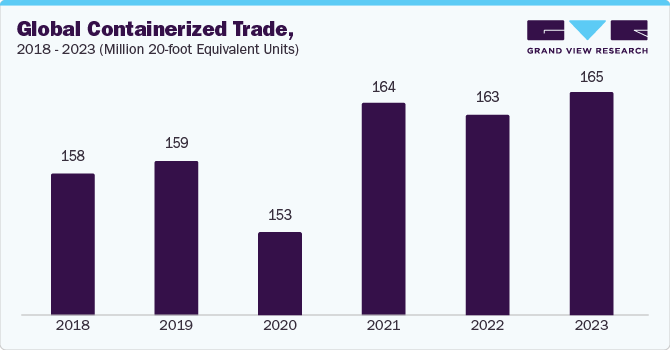- Home
- »
- Market Trend Reports
- »
-
Shipped Containers Import Export Database
Industry Insights
Shipped containers means the volume of loaded containers that are shipped during import and export trade across the globe. The container traffic is represented in a twenty-foot equivalent unit (TEU). Dry containers also known as freight containers, are the most common shipping containers available in various sizes as per the International Organization for Standardization (ISO). They are used for shipping dry materials and have common sizes such as 20 ft. and 40 ft. However, these containers lack temperature control and are not suitable for the transportation of food and chemicals that require refrigeration.
These containers are airtight and effectively prevent damage to inside goods from harsh conditions. Most of the dry containers are made using steel; however, in some cases, aluminum is used. These containers offer affordable storage and are used in a wide variety of applications. They are used for most of the shipping movement of dry goods packed in boxes, barrels, sacks, drums, cartons, cases, and pallets at international and domestic levels.

The 20’ shipping containers are standard-sized containers with a length of 20 feet. The dimensions of these containers comply with the international standard, ISO 668:1995. The main structured parts such as rails, posts, walls, and corner fittings of 20’ shipping containers are made from steel.

According to the UNCTAD, international seaborne trade volume contracted by 0.4% in 2022, reaching 12,027 million tons, down from 12,072 million tons in 2021. Weaker global economic growth, high inflation impacting consumer spending, and the disruption caused by the war in Ukraine had a particular impact. Global shipping is also facing concurrent forces that make balancing supply and demand a challenging task for carriers. On the supply side, container shipping may have entered an overcapacity phase, meaning that carriers will aim at managing capacity using tools such as slippage, idling of vessels, or demolition.
Scope Details
Attribute
Details
Total number of tabs in the database
32
Total number of countries in the database
28
Deliverable format
Excel
Country scope
U.S.; Canada; Mexico; Germany; UK; France; Italy; Spain; Sweden; Netherlands; China; Singapore; Japan; India; South Korea; Australia; Indonesia; Malaysia; Thailand; Vietnam; Sri Lanka; Brazil; Argentina; UAE; Morocco; Saudi Arabia; Oman
Share this report with your colleague or friend.
Pricing & Purchase Options
Service Guarantee
-
Insured Buying
This report has a service guarantee. We stand by our report quality.
-
Confidentiality
We are in compliance with GDPR & CCPA norms. All interactions are confidential.
-
Custom research service
Design an exclusive study to serve your research needs.
-
24/5 Research support
Get your queries resolved from an industry expert.
-
We are committed towards customer satisfaction, and quality service.
Client Testimonials

"The quality of research they have done for us has been excellent..."
ISO Certified


